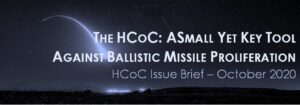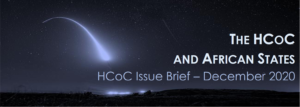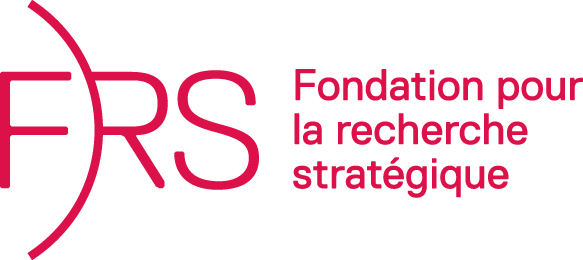The HCoC at Twenty
HCoC Issue Brief – November 2022
Universalisation and implementation over 20 years
With 93 subscribing states at its inception in 2002, the Code has significantly grown, counting now 143 signatories. Among recent subscribers figure some states possessing ballistic capacities, such as India, which joined in June 2016, but also states that do not but still seek to bring a contribution to this multilateral effort towards non-proliferation, for instance Saint Vincent and the Grenadines, which joined in January 2020. The Code has therefore remained a dynamic instrument in the last two decades with a steady increase in the number of subscribers (Figure 1).

In brief
Since its inception and through the collective outreach efforts of its Chairs, the Executive Secretariat, the EU and the United Nations, the Hague Code of Conduct has received growing support. It has improved its efficiency and implementation through a series of initiatives which have made it more easily accessible.
For twenty years, HCoC subscribing states have worked together in order to reduce the proliferation of ballistic missiles by implementing confidence-building measures and encouraging transparency.
Despite shortcomings and difficulties in assessing its concrete impact, it constitutes a unique and invaluable tool to face future proliferation challenges, particularly in a context of rising international tensions.
Authors: Emmanuelle Maitre & Solène Meyzonnade

In terms of implementation, the Code has experiences positive developments. For instance, the use of pre-launch notifications (PLNs) for long range missile tests as well as satellite launch vehicles (SLVs) has been generalised in the last decades, despite obstacles such as the existence of pre-existent bilateral agreements between some major powers such as the United States and Russia.
The HCoC rotating Chairmanship
The rotating Chairmanship of the Hague Code of Conduct was held by states from Europe, Asia, Africa as well as Latin America (Figure 2). The responsibilities which accompany such a position include outreach efforts to promote the Code and its principles, and increase its global visibility. Chairs, among other things, have successfully striven to increase the number of positive votes in favour of UN Resolutions supporting the HCoC.
Indeed, thanks to the efforts of the successive Chairs, Austria, the Immediate Central Contact/Executive Secretariat (ICC) and of the European Union (EU) through an important programme in support of the Code, the implementation of the Code has improved over the years. Thus, the HCoC restricted website made it considerably easier for subscribing states to access resources and fill in their annual declarations as well as PLNs. Moreover, the Subscribing States’ 4th annual meeting, which took place in 2004, saw the introduction of the Nil Form, a simplified annual declaration form created in order to encourage submissions. These changes enabled a visible increase in the number of annual declarations handed in each year, especially from states with no ballistic capacities, which was of only about a third in 2005 but increased to more than two thirds a few years later. For states with space launchers or ballistic missiles, the implementation rate is now perfectly satisfactory. Furthermore, in 2021, thanks to the EU’s support, the Code’s website was overhauled and improved, and the platform upgraded, making it much more accessible and easier to use.
Lastly, the Code’s emphasis on transparency was illustrated by a number of visits organized by signatories to some of their space centres and launch sites, in accordance with article 4.a.iii of the Code. In 2004, Norway opened the doors of its Andøya site, Japan did the same with the Tanegashima Space Centre in 2005, and France – with the Kourou Space Centre in Guiana in 2011 and 2022.
A unique multilateral forum to discuss missile proliferation
Besides some clear practical improvements such as the Nil Form, the Regular Annual Meetings (ARMs) of the Code have offered the signatories of the Code, since its inception, a crucial and rare opportunity to come together yearly to voice their concerns on ballistic proliferation and to discuss underlying security issues.
For instance, during the 12th (2013) and 14th (2015) annual meetings, Subscribing States underlined their concerns regarding the acceleration of North Korea’s missile programme, visible through its increased number of ballistic missile tests. They also noted worrying proliferation trends in the Middle East, North-East Asia and South Asia. During their 17th meeting (2018), they welcomed Pyongyang’s decision to stop ballistic launches.
Current trends and next ten-year challenges for the Code
Despite its achievements, the Code may face challenges in the future that may require some adaptations. The first set of challenges relates to trends in missile dissemination. Indeed, some missile programmes, potentially linked with weapons of mass destruction (WMDs) developments are still underway, including long-range missiles, particularly in the Middle East. Since early 2021, North Korea has significantly sped up its missile and nuclear programmes, increasing concerns within the international community. If these developments remain preoccupying, it should be noted that compared to 2002, less countries are currently attempting to develop ballistic weapons to carry WMDs. But an important challenge is how to address the dissemination of conventional missiles and their increasing employment on the battlefield and what role the Code can play on this issue.1 This use on military theatres has been noted in conflicts between Armenia and Azerbaijan (2020) and Russia and Ukraine (2022). Furthermore, in the context of regional and internal conflicts, non-state actors have also had access to and used ballistic technology, raising concerns about illicit networks of proliferation. It is the case of the Houthis, an armed militia operating in Yemen and Saudi Arabia.

Since the start of the 21st century, a collective international effort to curb the proliferation of ballistic missiles, coupled with increased control on systems and counter-proliferation measures, has led to a drop in the transfers of missiles capable of carrying WMDs. Still, this general decrease has boosted incentives for countries to develop their own domestic capabilities to manufacture their arsenals, resulting in a number of countries possessing ballistic missiles as well as manufacturing technology and infrastructures.
The HCoC also faces technological challenges. While the Code draws a clear link between WMDs and ballistic missiles, other potential means of delivery are not taken into account despite the dangerous and disruptive potential they hold. It is the case, for instance, for cruise missiles, unmanned combat aerial vehicles (UCAVs) as well as certain types of hypersonic gliders. These various cases illustrate an important need for the Code’s Subscribing States to reflect on the scope of the HCoC and to adapt it to current dynamics in weapons development.2
Finally, political obstacles may come into play. Some states with significant ballistic capabilities and active programmes, such as China, Pakistan and Iran, have expressed continued reluctance to joining the Code. Reluctance of many countries in some regions, particularly in the Middle East, also curtails the Code’s efforts.
The importance of the HCoC in the current security environment
The scope of the HCoC has limits and its contribution to curtailing the proliferation of ballistic missiles is hard to evaluate. However, since 2002, it has had a substantial impact in fostering a more secure international environment by facilitating transparency and information sharing. It has created a unique forum where signatory states are free to voice their concerns and discuss their intentions, an opportunity ever so important considering the current stalemate currently faced by the arms control and the non-proliferation regime.
Despite its limitation, the HCoC needs to be preserved, and its universalisation and implementation should be promoted. In order to face the challenges ahead efficiently, it will have to find ways to react and adapt to changing circumstances. Its non-binding nature and wide support may be key assets to provide the flexibility necessary to ensure its continued relevance over the next ten years.
About the Hague Code of Conduct
Adopted in 2002, the Hague Code of Conduct against Ballistic Missile Proliferation (HCoC) is a politically binding instrument aiming to limit the proliferation of weapons of mass destruction (WMD) delivery vehicles. Composed of a set of transparency and confidence-building measures, the HCoC is the only existing multilateral instrument to focus on WMD delivery vehicles. The HCoC has reached 143 subscribing states (November 2022) vs 93 at its inception.
When subscribing to the HCoC, states commit to abide by a set of UN treaties and international conventions on space security; to produce an annual declaration regarding ballistic missile capacities and national policy on non-proliferation and disarmament treaties and instruments; and to deliver pre-launch notifications prior to any missile or space launch. Documents are uploaded onto a dedicated online platform managed by Austria, which acts as the HCoC Immediate Central Contact (Executive Secretariat). Subscription to the HCoC is free of charge.
While subscribing states are asked to exercise ‘maximum restraint’ in the development of ballistic capacities, they are proscribed neither from possessing ballistic missiles nor from pursuing space launch activities. In return, subscribing to the HCoC enables states to gain access to information shared by other subscribing states, and to display their political commitment to non-proliferation and disarmament.
i Stéphane Delory, ‘Ballistic missiles and conventional strike weapons,’ HCoC Research Paper n°6, FRS, January 2020.
ii Stéphane Delory, Emmanuelle Maitre and Jean Masson, ‘Opening HCoC to cruise missiles,’ HCoC Research Papers n°5, FRS, February 2019.





